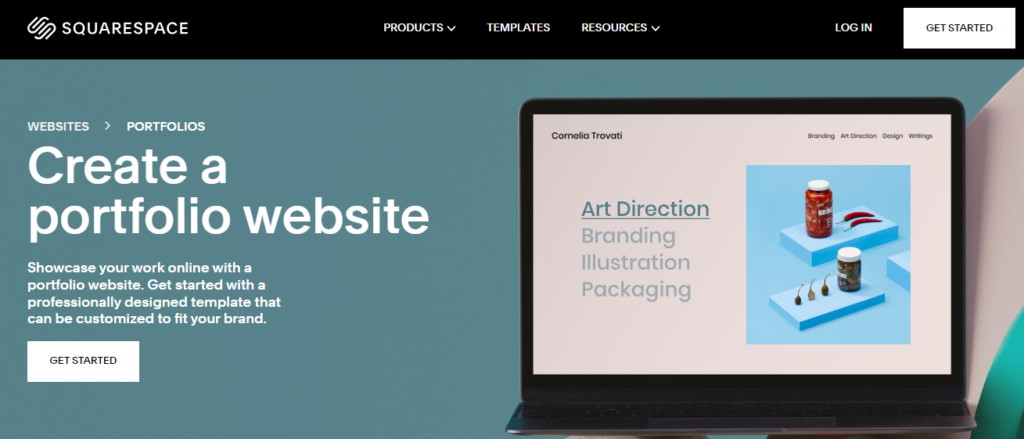
In today’s digital age, the internet has become a powerful platform for artists to showcase and sell their work. With the click of a button, artists can reach a global audience, connect with potential buyers, and turn their passion into profit. If you’re an artist looking to sell your art online, this guide is for you. From setting up your online presence to marketing your artwork effectively, here’s everything you need to know to succeed in the world of online art sales.
1. Create a Stunning Online Portfolio
Your online portfolio serves as your virtual gallery, showcasing your artwork to potential buyers. Invest time in creating a visually appealing and user-friendly website or utilize online platforms like Etsy, Shopify, or Squarespace to display your art. Make sure to include high-quality images of your artwork from multiple angles and provide detailed descriptions, including dimensions, medium, and inspiration behind each piece.

Your online portfolio is your digital calling card, your virtual gallery, and your ultimate showcase to the world. It’s the place where your artistic vision comes to life, where your creativity takes center stage, and where potential buyers can immerse themselves in the beauty of your artwork. A stunning online portfolio isn’t just a collection of images; it’s a carefully curated presentation that captivates visitors and leaves a lasting impression.
In your online portfolio, every detail matters. From the layout and design to the quality of your images, each element should reflect your unique style and artistic voice. Choose a clean and modern design that complements your artwork without overshadowing it. Opt for a user-friendly interface that allows visitors to navigate seamlessly through your portfolio and explore your pieces with ease.
When it comes to showcasing your artwork, quality is paramount. Invest in professional photography or digital imaging to capture your pieces in their best light. Ensure that each image is high-resolution, properly cropped, and accurately represents the colors and details of your artwork. Provide descriptive captions and background information for each piece, giving visitors insight into your creative process, inspiration, and artistic journey.
In addition to showcasing your finished artwork, consider including behind-the-scenes glimpses, work-in-progress shots, and personal anecdotes that offer a deeper connection to your art and your audience. Share your story, your passion, and your artistic vision, inviting visitors to engage with your work on a deeper level.
Your online portfolio is more than just a static collection of images; it’s a dynamic reflection of who you are as an artist. Regularly update your portfolio with new pieces, fresh content, and insights into your evolving artistic journey. Keep your portfolio responsive and accessible across all devices, ensuring that visitors can experience your artwork wherever they are.
Above all, remember that your online portfolio is your digital storefront, your online gallery, and your virtual stage. Take pride in presenting your artwork to the world, and let your passion and creativity shine through in every detail. With a stunning online portfolio, you can captivate audiences, connect with buyers, and showcase your artistry to the world.
2. Price Your Art Realistically
Pricing your art can be challenging, but it’s essential to strike a balance between profitability and attractiveness to buyers. Research the market and compare prices of similar artworks to determine a fair value for your pieces. Consider factors such as materials, size, complexity, and your level of expertise when setting prices. Be transparent about your pricing and offer options for various budgets to attract a wider range of buyers.

Setting the right price for your artwork is pivotal for success in the online art market. Strike a balance between profitability and attractiveness to buyers by researching the market, considering factors such as materials, size, and complexity, and being transparent about your pricing. By valuing your work realistically, you not only ensure fair compensation for your talent and effort but also attract buyers who appreciate the true worth of your art.
3. Optimize for Search Engines
To increase visibility and attract potential buyers, optimize your website or online store for search engines. Use relevant keywords related to your artwork in your website’s meta tags, titles, descriptions, and image alt text. Regularly update your content and incorporate blog posts or articles about your artistic process, inspiration, and upcoming exhibitions to improve your website’s search engine ranking.

Maximize the visibility of your artwork online by optimizing your website or online store for search engines. Enhance your website’s ranking in search results by strategically incorporating relevant keywords related to your artwork into meta tags, titles, descriptions, and image alt text. Regularly update your content and share insights about your artistic process to improve your online presence and attract a broader audience of art enthusiasts. By leveraging search engine optimization techniques, you can increase traffic to your website and connect with potential buyers more effectively.
4. Leverage Social Media
Social media platforms like Instagram, Facebook, and Pinterest are powerful tools for promoting your artwork and connecting with art enthusiasts. Create a cohesive brand identity across your social media profiles and regularly share high-quality images of your artwork, behind-the-scenes glimpses, and engaging content to attract followers.

Harness the power of social media platforms like Instagram, Facebook, and Pinterest to elevate your artwork to a global audience. Build a captivating online presence by showcasing your art through visually stunning posts and engaging content. Cultivate a community of art enthusiasts by sharing behind-the-scenes glimpses, artist inspirations, and interactive experiences. Connect with fellow artists, collaborate with influencers, and engage with your followers to expand your reach and foster meaningful relationships. With social media as your canvas, you can amplify your artistic journey and cultivate a loyal following of art lovers from around the world.
5. Offer Secure Payment Options
Make it easy for buyers to purchase your artwork by offering secure payment options on your website or online store. Utilize trusted payment processors like PayPal, Stripe, or Square to accept credit card payments securely. Clearly outline your shipping and return policies to instill confidence in potential buyers and provide excellent customer service to ensure a positive buying experience.
“Offer Secure Payment Options” entails providing customers with a range of trustworthy and reliable payment methods to facilitate transactions while prioritizing their security and peace of mind. In today’s digital age, where online transactions are prevalent, ensuring the safety of payment information is paramount to maintaining customer trust and loyalty.
This approach involves implementing robust security measures to protect sensitive financial data, such as credit card details, personal information, and transaction history. It also involves offering a variety of payment options to cater to diverse customer preferences and needs.
Key elements of offering secure payment options include:
1. **Encryption and Data Protection**: Utilize encryption technologies and secure socket layers (SSL) to safeguard payment information during transmission. Encrypting data ensures that it is unreadable to unauthorized parties, reducing the risk of interception and theft.
2. **Compliance with Industry Standards**: Adhere to industry standards and regulations, such as the Payment Card Industry Data Security Standard (PCI DSS), to ensure the secure handling of payment data. Compliance demonstrates a commitment to maintaining high security standards and protecting customer information.
3. **Trusted Payment Gateways**: Partner with reputable payment gateway providers that offer secure and reliable payment processing services.
4. **Multi-factor Authentication**: Implement multi-factor authentication methods, such as one-time passwords (OTP) or biometric verification, to add an extra layer of security to the payment process. Multi-factor authentication helps verify the identity of users and reduces the risk of unauthorized access.
5. **Tokenization**: Employ tokenization techniques to replace sensitive payment data with unique tokens that have no intrinsic value. Tokenization minimizes the exposure of sensitive information, as tokens cannot be used to reconstruct the original payment data even if intercepted.
6. **Regular Security Audits and Updates**: Conduct regular security audits and assessments to identify vulnerabilities and address potential threats. Stay informed about emerging security trends and update systems and protocols accordingly to mitigate risks effectively.
7. **Transparent Privacy Policies**: Clearly communicate your privacy policies and security practices to customers, assuring them of the measures taken to protect their payment information. Transparency builds trust and confidence among customers and encourages them to transact with confidence.
By offering secure payment options, businesses demonstrate their commitment to protecting customer privacy and security, fostering trust and confidence in their brand. Additionally, providing a seamless and secure payment experience enhances customer satisfaction and encourages repeat purchases, contributing to long-term business success.
6. Build Relationships with Your Audience
Building a loyal customer base is essential for long-term success in selling art online. Engage with your audience regularly through email newsletters, personalized messages, and exclusive offers. Encourage satisfied customers to leave reviews and testimonials to build credibility and trust with new buyers. Consider offering incentives such as discounts or freebies for repeat purchases to reward customer loyalty.
“Build Relationships with Your Audience” is a strategic approach that focuses on cultivating strong connections and rapport with a target demographic or community. Whether in business, entertainment, or any other field, establishing meaningful relationships with your audience is paramount for long-term success and sustainability.
This concept involves engaging with your audience on a personal level, understanding their needs, preferences, and concerns, and actively involving them in your endeavors. It goes beyond mere transactional interactions to foster genuine trust, loyalty, and mutual understanding.
To effectively build relationships with your audience, various strategies can be employed:
1. **Authentic Communication**: Transparency and authenticity are key. Communicate openly and honestly with your audience, sharing your values, mission, and goals.
2. **Active Listening**: Take the time to listen to your audience’s feedback, opinions, and suggestions.
3. **Engagement**: Actively engage with your audience through various channels such as social media, email newsletters, forums, and events. Respond promptly to inquiries and comments, and initiate conversations to keep them engaged.
4. **Personalization**: Tailor your content and interactions to suit the preferences and interests of your audience. Personalization demonstrates that you understand and care about their individual needs.
5. **Consistency**: Maintain a consistent presence and voice across all platforms to reinforce your brand identity and build familiarity with your audience.
6. **Provide Value**: Offer valuable content, resources, or experiences that enrich your audience’s lives or address their pain points. By providing genuine value, you solidify your relationship with them.
7. **Community Building**: Foster a sense of community among your audience members by encouraging interaction and collaboration. Create opportunities for them to connect with each other and share their experiences.
8. **Feedback Loop**: Establish a feedback loop where you regularly solicit feedback from your audience and use it to improve your products, services, or content offerings.
By prioritizing relationship-building with your audience, you not only increase customer satisfaction and loyalty but also lay the foundation for sustained growth and success in the long run. Building strong connections with your audience can lead to brand advocacy, word-of-mouth referrals, and ultimately, a thriving and supportive community around your brand or endeavor.
7. Stay Updated and Adapt
The online art market is constantly evolving, so it’s crucial to stay updated on industry trends, technology advancements, and changes in consumer behavior. Continuously evaluate your sales strategies, website performance, and marketing efforts to identify areas for improvement and adapt accordingly. Embrace new opportunities, such as virtual exhibitions, online auctions, or collaborations with other artists, to expand your reach and grow your online art business.

In conclusion, selling art online requires a combination of creativity, business savvy, and digital marketing skills. By creating a stunning online portfolio, pricing your art realistically, optimizing for search engines, leveraging social media, offering secure payment options, building relationships with your audience, and staying updated on industry trends, you can successfully sell your art to a global audience and turn your passion into profit. With dedication and perseverance, the possibilities for online art sales are endless.
Leave a Reply